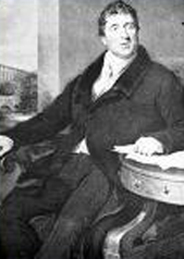 [Edit photo credit]
[Edit photo credit]1757 – 1834
During his prodigious life, Thomas Telford was credited with building over 1,000 miles of roadway, 1,000 bridges, 40 harbors and piers, and numerous canals. The fact that Telford had little formal training in engineering makes his achievements even more striking. What Telford knew he knew from experience, and he understood the principles of building materials because he had worked them with his own hands.
Telford was born August 9, 1757 in the Scottish southern uplands. His father John was a shepherd who tragically died three months after his son's birth. Thomas and his mother Janet were forced to move from their house to a single room, and Thomas spent his childhood working long hours for local farmers. When Thomas reached adolescence he was apprenticed to the town stonemason who was constructing a new bridge across the Esk River at Langholm. Following the completion of the bridge Telford became a full-fledged journeyman, and he set off in 1780 to make his mark, first in Edinburgh, then in London. Part of his journey took him to Shropshire near the English-Welsh border where he constructed bridges over the Severn River at Montford, Buildwas, and Bewdley. During these years Telford amassed considerable experience and made connections with important men. With the coming of the "canal mania" of the 1790s, Telford's career took a new direction, and in a matter of years he would become Britain's prominent figure in the design of canals and locks. His most notable achievement was the Caledonian Canal, which joined Inverness to Fort William in Northern Scotland. Telford employed the latest technology, including stream engine pumps and steam powered dredging equipment. For the massive lock known as Neptune's staircase, 120 masons were employed full time.
After nineteen years and 550,000 pounds over cost, the canal was finally opened in October 1822. During these same years Telford had many projects that overlapped, including the Holyhead road through Wales (site of the modern A5) and the cast iron Waterloo Bridge, constructed the year of the Battle of Waterloo. The grandest and most prestigious bridge built by Telford was the suspension bridge over the Menai Straits. Designed by Telford in 1818, the bridge's 153-foot towers supported a central span that dwarfed anything ever attempted by bridge builders, extending 579 feet across and suspended 100 feet above the water. With the completion of the Menai bridge, Telford utilized his growing reputation to further the cause of the engineering profession, and in 1820 he became the President of the newly formed Institution of Civil Engineers. Unlike John Smeaton's Society of Civil Engineers founded in 1771, Telford wanted the new Institution to be less of an exclusive social organization and concentrate more on the technical aspects of engineering. Telford also used the Institution to promote canal interests in the face of the emergent railway lobby.
Telford's growing conservative outlook was best exemplified in a clash with Isambard Brunel over the design for a new bridge across the Avon Gorge at Clifton. The 24-year-old Brunel, who studied Telford's Menai Bridge, submitted a bridge design that called for an unprecedented span of 1160 feet. The 73-year-old Telford was called in to consult on the project, and his response was that the Menai Bridge represented the maximum length of a suspension bridge due to instability generated by wind. Telford submitted his own design, only to lose out to the upstart Brunel in the end. In spite of this incident, Thomas Telford was honored as the greatest engineer of his generation, and was buried at Westminster Abbey.

